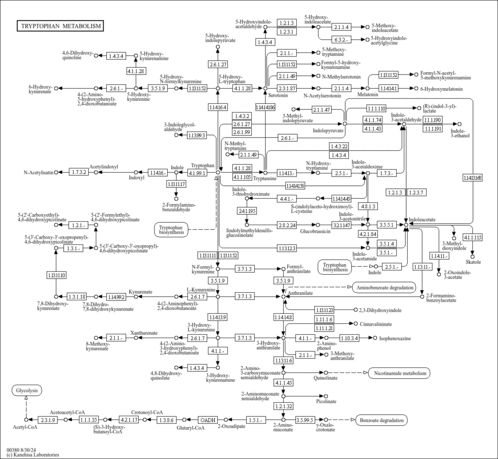| N'-Formylkynurenine,1TMS,isomer #1 | C[Si](C)(C)OC(=O)C(N)CC(=O)C1=CC=CC=C1NC=O | 2332.0 | Semi standard non polar | 33892256 |
| N'-Formylkynurenine,1TMS,isomer #2 | C[Si](C)(C)NC(CC(=O)C1=CC=CC=C1NC=O)C(=O)O | 2331.6 | Semi standard non polar | 33892256 |
| N'-Formylkynurenine,1TMS,isomer #3 | C[Si](C)(C)N(C=O)C1=CC=CC=C1C(=O)CC(N)C(=O)O | 2232.2 | Semi standard non polar | 33892256 |
| N'-Formylkynurenine,2TMS,isomer #1 | C[Si](C)(C)NC(CC(=O)C1=CC=CC=C1NC=O)C(=O)O[Si](C)(C)C | 2335.9 | Semi standard non polar | 33892256 |
| N'-Formylkynurenine,2TMS,isomer #1 | C[Si](C)(C)NC(CC(=O)C1=CC=CC=C1NC=O)C(=O)O[Si](C)(C)C | 2286.8 | Standard non polar | 33892256 |
| N'-Formylkynurenine,2TMS,isomer #1 | C[Si](C)(C)NC(CC(=O)C1=CC=CC=C1NC=O)C(=O)O[Si](C)(C)C | 3070.2 | Standard polar | 33892256 |
| N'-Formylkynurenine,2TMS,isomer #2 | C[Si](C)(C)OC(=O)C(N)CC(=O)C1=CC=CC=C1N(C=O)[Si](C)(C)C | 2206.6 | Semi standard non polar | 33892256 |
| N'-Formylkynurenine,2TMS,isomer #2 | C[Si](C)(C)OC(=O)C(N)CC(=O)C1=CC=CC=C1N(C=O)[Si](C)(C)C | 2323.5 | Standard non polar | 33892256 |
| N'-Formylkynurenine,2TMS,isomer #2 | C[Si](C)(C)OC(=O)C(N)CC(=O)C1=CC=CC=C1N(C=O)[Si](C)(C)C | 3034.0 | Standard polar | 33892256 |
| N'-Formylkynurenine,2TMS,isomer #3 | C[Si](C)(C)N(C(CC(=O)C1=CC=CC=C1NC=O)C(=O)O)[Si](C)(C)C | 2468.0 | Semi standard non polar | 33892256 |
| N'-Formylkynurenine,2TMS,isomer #3 | C[Si](C)(C)N(C(CC(=O)C1=CC=CC=C1NC=O)C(=O)O)[Si](C)(C)C | 2444.6 | Standard non polar | 33892256 |
| N'-Formylkynurenine,2TMS,isomer #3 | C[Si](C)(C)N(C(CC(=O)C1=CC=CC=C1NC=O)C(=O)O)[Si](C)(C)C | 3284.6 | Standard polar | 33892256 |
| N'-Formylkynurenine,2TMS,isomer #4 | C[Si](C)(C)NC(CC(=O)C1=CC=CC=C1N(C=O)[Si](C)(C)C)C(=O)O | 2243.9 | Semi standard non polar | 33892256 |
| N'-Formylkynurenine,2TMS,isomer #4 | C[Si](C)(C)NC(CC(=O)C1=CC=CC=C1N(C=O)[Si](C)(C)C)C(=O)O | 2399.0 | Standard non polar | 33892256 |
| N'-Formylkynurenine,2TMS,isomer #4 | C[Si](C)(C)NC(CC(=O)C1=CC=CC=C1N(C=O)[Si](C)(C)C)C(=O)O | 2997.0 | Standard polar | 33892256 |
| N'-Formylkynurenine,3TMS,isomer #1 | C[Si](C)(C)OC(=O)C(CC(=O)C1=CC=CC=C1NC=O)N([Si](C)(C)C)[Si](C)(C)C | 2489.8 | Semi standard non polar | 33892256 |
| N'-Formylkynurenine,3TMS,isomer #1 | C[Si](C)(C)OC(=O)C(CC(=O)C1=CC=CC=C1NC=O)N([Si](C)(C)C)[Si](C)(C)C | 2402.0 | Standard non polar | 33892256 |
| N'-Formylkynurenine,3TMS,isomer #1 | C[Si](C)(C)OC(=O)C(CC(=O)C1=CC=CC=C1NC=O)N([Si](C)(C)C)[Si](C)(C)C | 2933.1 | Standard polar | 33892256 |
| N'-Formylkynurenine,3TMS,isomer #2 | C[Si](C)(C)NC(CC(=O)C1=CC=CC=C1N(C=O)[Si](C)(C)C)C(=O)O[Si](C)(C)C | 2236.9 | Semi standard non polar | 33892256 |
| N'-Formylkynurenine,3TMS,isomer #2 | C[Si](C)(C)NC(CC(=O)C1=CC=CC=C1N(C=O)[Si](C)(C)C)C(=O)O[Si](C)(C)C | 2352.2 | Standard non polar | 33892256 |
| N'-Formylkynurenine,3TMS,isomer #2 | C[Si](C)(C)NC(CC(=O)C1=CC=CC=C1N(C=O)[Si](C)(C)C)C(=O)O[Si](C)(C)C | 2706.9 | Standard polar | 33892256 |
| N'-Formylkynurenine,3TMS,isomer #3 | C[Si](C)(C)N(C=O)C1=CC=CC=C1C(=O)CC(C(=O)O)N([Si](C)(C)C)[Si](C)(C)C | 2393.1 | Semi standard non polar | 33892256 |
| N'-Formylkynurenine,3TMS,isomer #3 | C[Si](C)(C)N(C=O)C1=CC=CC=C1C(=O)CC(C(=O)O)N([Si](C)(C)C)[Si](C)(C)C | 2519.1 | Standard non polar | 33892256 |
| N'-Formylkynurenine,3TMS,isomer #3 | C[Si](C)(C)N(C=O)C1=CC=CC=C1C(=O)CC(C(=O)O)N([Si](C)(C)C)[Si](C)(C)C | 2870.6 | Standard polar | 33892256 |
| N'-Formylkynurenine,4TMS,isomer #1 | C[Si](C)(C)OC(=O)C(CC(=O)C1=CC=CC=C1N(C=O)[Si](C)(C)C)N([Si](C)(C)C)[Si](C)(C)C | 2440.9 | Semi standard non polar | 33892256 |
| N'-Formylkynurenine,4TMS,isomer #1 | C[Si](C)(C)OC(=O)C(CC(=O)C1=CC=CC=C1N(C=O)[Si](C)(C)C)N([Si](C)(C)C)[Si](C)(C)C | 2476.0 | Standard non polar | 33892256 |
| N'-Formylkynurenine,4TMS,isomer #1 | C[Si](C)(C)OC(=O)C(CC(=O)C1=CC=CC=C1N(C=O)[Si](C)(C)C)N([Si](C)(C)C)[Si](C)(C)C | 2656.6 | Standard polar | 33892256 |
| N'-Formylkynurenine,1TBDMS,isomer #1 | CC(C)(C)[Si](C)(C)OC(=O)C(N)CC(=O)C1=CC=CC=C1NC=O | 2595.0 | Semi standard non polar | 33892256 |
| N'-Formylkynurenine,1TBDMS,isomer #2 | CC(C)(C)[Si](C)(C)NC(CC(=O)C1=CC=CC=C1NC=O)C(=O)O | 2590.8 | Semi standard non polar | 33892256 |
| N'-Formylkynurenine,1TBDMS,isomer #3 | CC(C)(C)[Si](C)(C)N(C=O)C1=CC=CC=C1C(=O)CC(N)C(=O)O | 2489.5 | Semi standard non polar | 33892256 |
| N'-Formylkynurenine,2TBDMS,isomer #1 | CC(C)(C)[Si](C)(C)NC(CC(=O)C1=CC=CC=C1NC=O)C(=O)O[Si](C)(C)C(C)(C)C | 2833.3 | Semi standard non polar | 33892256 |
| N'-Formylkynurenine,2TBDMS,isomer #1 | CC(C)(C)[Si](C)(C)NC(CC(=O)C1=CC=CC=C1NC=O)C(=O)O[Si](C)(C)C(C)(C)C | 2746.6 | Standard non polar | 33892256 |
| N'-Formylkynurenine,2TBDMS,isomer #1 | CC(C)(C)[Si](C)(C)NC(CC(=O)C1=CC=CC=C1NC=O)C(=O)O[Si](C)(C)C(C)(C)C | 3171.3 | Standard polar | 33892256 |
| N'-Formylkynurenine,2TBDMS,isomer #2 | CC(C)(C)[Si](C)(C)OC(=O)C(N)CC(=O)C1=CC=CC=C1N(C=O)[Si](C)(C)C(C)(C)C | 2670.2 | Semi standard non polar | 33892256 |
| N'-Formylkynurenine,2TBDMS,isomer #2 | CC(C)(C)[Si](C)(C)OC(=O)C(N)CC(=O)C1=CC=CC=C1N(C=O)[Si](C)(C)C(C)(C)C | 2740.1 | Standard non polar | 33892256 |
| N'-Formylkynurenine,2TBDMS,isomer #2 | CC(C)(C)[Si](C)(C)OC(=O)C(N)CC(=O)C1=CC=CC=C1N(C=O)[Si](C)(C)C(C)(C)C | 3166.9 | Standard polar | 33892256 |
| N'-Formylkynurenine,2TBDMS,isomer #3 | CC(C)(C)[Si](C)(C)N(C(CC(=O)C1=CC=CC=C1NC=O)C(=O)O)[Si](C)(C)C(C)(C)C | 2968.5 | Semi standard non polar | 33892256 |
| N'-Formylkynurenine,2TBDMS,isomer #3 | CC(C)(C)[Si](C)(C)N(C(CC(=O)C1=CC=CC=C1NC=O)C(=O)O)[Si](C)(C)C(C)(C)C | 2841.9 | Standard non polar | 33892256 |
| N'-Formylkynurenine,2TBDMS,isomer #3 | CC(C)(C)[Si](C)(C)N(C(CC(=O)C1=CC=CC=C1NC=O)C(=O)O)[Si](C)(C)C(C)(C)C | 3293.1 | Standard polar | 33892256 |
| N'-Formylkynurenine,2TBDMS,isomer #4 | CC(C)(C)[Si](C)(C)NC(CC(=O)C1=CC=CC=C1N(C=O)[Si](C)(C)C(C)(C)C)C(=O)O | 2721.6 | Semi standard non polar | 33892256 |
| N'-Formylkynurenine,2TBDMS,isomer #4 | CC(C)(C)[Si](C)(C)NC(CC(=O)C1=CC=CC=C1N(C=O)[Si](C)(C)C(C)(C)C)C(=O)O | 2777.5 | Standard non polar | 33892256 |
| N'-Formylkynurenine,2TBDMS,isomer #4 | CC(C)(C)[Si](C)(C)NC(CC(=O)C1=CC=CC=C1N(C=O)[Si](C)(C)C(C)(C)C)C(=O)O | 3151.7 | Standard polar | 33892256 |
| N'-Formylkynurenine,3TBDMS,isomer #1 | CC(C)(C)[Si](C)(C)OC(=O)C(CC(=O)C1=CC=CC=C1NC=O)N([Si](C)(C)C(C)(C)C)[Si](C)(C)C(C)(C)C | 3185.0 | Semi standard non polar | 33892256 |
| N'-Formylkynurenine,3TBDMS,isomer #1 | CC(C)(C)[Si](C)(C)OC(=O)C(CC(=O)C1=CC=CC=C1NC=O)N([Si](C)(C)C(C)(C)C)[Si](C)(C)C(C)(C)C | 3023.4 | Standard non polar | 33892256 |
| N'-Formylkynurenine,3TBDMS,isomer #1 | CC(C)(C)[Si](C)(C)OC(=O)C(CC(=O)C1=CC=CC=C1NC=O)N([Si](C)(C)C(C)(C)C)[Si](C)(C)C(C)(C)C | 3132.9 | Standard polar | 33892256 |
| N'-Formylkynurenine,3TBDMS,isomer #2 | CC(C)(C)[Si](C)(C)NC(CC(=O)C1=CC=CC=C1N(C=O)[Si](C)(C)C(C)(C)C)C(=O)O[Si](C)(C)C(C)(C)C | 2877.9 | Semi standard non polar | 33892256 |
| N'-Formylkynurenine,3TBDMS,isomer #2 | CC(C)(C)[Si](C)(C)NC(CC(=O)C1=CC=CC=C1N(C=O)[Si](C)(C)C(C)(C)C)C(=O)O[Si](C)(C)C(C)(C)C | 2947.7 | Standard non polar | 33892256 |
| N'-Formylkynurenine,3TBDMS,isomer #2 | CC(C)(C)[Si](C)(C)NC(CC(=O)C1=CC=CC=C1N(C=O)[Si](C)(C)C(C)(C)C)C(=O)O[Si](C)(C)C(C)(C)C | 3017.5 | Standard polar | 33892256 |
| N'-Formylkynurenine,3TBDMS,isomer #3 | CC(C)(C)[Si](C)(C)N(C=O)C1=CC=CC=C1C(=O)CC(C(=O)O)N([Si](C)(C)C(C)(C)C)[Si](C)(C)C(C)(C)C | 3071.4 | Semi standard non polar | 33892256 |
| N'-Formylkynurenine,3TBDMS,isomer #3 | CC(C)(C)[Si](C)(C)N(C=O)C1=CC=CC=C1C(=O)CC(C(=O)O)N([Si](C)(C)C(C)(C)C)[Si](C)(C)C(C)(C)C | 3048.0 | Standard non polar | 33892256 |
| N'-Formylkynurenine,3TBDMS,isomer #3 | CC(C)(C)[Si](C)(C)N(C=O)C1=CC=CC=C1C(=O)CC(C(=O)O)N([Si](C)(C)C(C)(C)C)[Si](C)(C)C(C)(C)C | 3102.5 | Standard polar | 33892256 |
| N'-Formylkynurenine,4TBDMS,isomer #1 | CC(C)(C)[Si](C)(C)OC(=O)C(CC(=O)C1=CC=CC=C1N(C=O)[Si](C)(C)C(C)(C)C)N([Si](C)(C)C(C)(C)C)[Si](C)(C)C(C)(C)C | 3302.1 | Semi standard non polar | 33892256 |
| N'-Formylkynurenine,4TBDMS,isomer #1 | CC(C)(C)[Si](C)(C)OC(=O)C(CC(=O)C1=CC=CC=C1N(C=O)[Si](C)(C)C(C)(C)C)N([Si](C)(C)C(C)(C)C)[Si](C)(C)C(C)(C)C | 3214.4 | Standard non polar | 33892256 |
| N'-Formylkynurenine,4TBDMS,isomer #1 | CC(C)(C)[Si](C)(C)OC(=O)C(CC(=O)C1=CC=CC=C1N(C=O)[Si](C)(C)C(C)(C)C)N([Si](C)(C)C(C)(C)C)[Si](C)(C)C(C)(C)C | 2986.9 | Standard polar | 33892256 |
